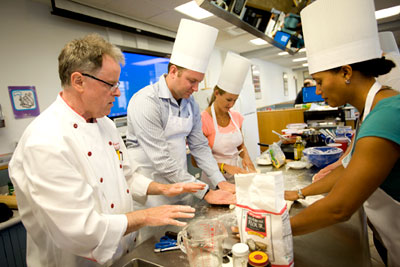'Gastronauts' practice Martian cooking techniques for deep-space delicacies
By Joyanna Gilmour

How hard would it be to cook on Mars? Nine "gastronauts" tried to answer that question during a four-day Cornell workshop June 12-15. Using only shelf-stable, dehydrated foods, they learned how to make such deep-space delicacies as seaweed salad, curry chicken crepes, Puerto Rican-style white bean stew, and chocolate pudding with raspberries.
Members of the NASA-funded Hawaii Space Exploration Analogue and Simulation (HI-SEAS) research team, selected from 600 applicants, are developing menus and techniques for cooking healthy, tasty foods in a deep-space environment. The HI-SEAS project is led by Jean Hunter, associate professor of biological and environmental engineering; Bruce Halpern, professor of psychology and neurobiology and behavior; and Kim Binsted, associate professor in the University of Hawaii's Information and Computer Sciences Department.
Rupert Spies, senior lecturer at Cornell's School of Hotel Administration, took charge of the hands-on portion of the workshop in a Martha Van Rensselaer Hall kitchen, teaching how to be creative using dehydrated fruits, vegetables, meats and cheeses. Participants came up with menus, including a paella made of dried shrimp, shelf-stable chorizo and dehydrated vegetables; coffee granita; and a fruit smoothie using yogurt prepared from dried milk.
The overall goal of HI-SEAS is to explore whether teaching astronauts to cook in space will improve the taste and nutrition of meals for long-term space missions, such as a mission to Mars. The research team also is exploring the equipment, time and energy required to cook in a simulated Martian environment.
Astronauts on space missions eat shelf-stable, prepackaged meals that can be prepared by adding water. "There's only a certain number of these dishes that you can prepare, package and take to space," said Hunter. Over time, this limited selection of foods can lead to "menu fatigue," in which even previously enjoyable meals become unappetizing over the course of a mission. This can make it difficult for astronauts to meet their nutritional needs.
Complicating the situation are the effects of microgravity, or zero gravity, which causes body fluids to shift, changing astronauts' senses of smell and taste.
"What we're trying to do is to enable long-term space exploration, and food is a really significant part of that," said Binsted. "We're trying to make sure that they get a nutritionally balanced diet as well as food they're willing to eat over the long-term."
Following the workshop, six trainees will be selected as the crew of a 120-day space simulation in a Mars-like habitat located on a volcanic mountain in Hawaii. The Martian simulation, scheduled for next spring, will explore the challenges of cooking, eating and living in space.
The HI-SEAS crew will face a number of challenges during the four-month simulation, including cooking at high altitudes. However, they won't be cooking in a zero-gravity environment; the simulated space station is designed to mimic the task of cooking on a planet's surface, where there is enough gravity "to hold the food in the bowl," said Binsted.
The HI-SEAS project actively seeks public participation and plans to launch a website in the fall, where people can submit recipes for the crew members to cook during the simulated space mission.
Whether on Earth or Mars, food can be a "morale-booster," said Hunter. "It's hard to put a price tag on that."
Graduate student Joyanna Gilmour is a writer intern for the Cornell Chronicle.
Media Contact
Get Cornell news delivered right to your inbox.
Subscribe